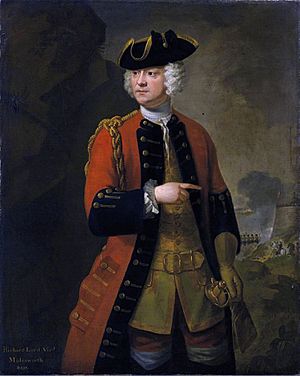Richard Molesworth, 3rd Viscount Molesworth facts for kids
Quick facts for kids
The Viscount Molesworth
|
|
|---|---|

Richard Molesworth, 3rd Viscount Molesworth
|
|
| Born | 1680 Swords, Dublin |
| Died | 12 October 1758 (aged 77 or 78) London, England |
| Buried |
Kensington, London
|
| Allegiance | |
| Service/ |
|
| Years of service | 1702–1758 |
| Rank | Field Marshal |
| Commands held | Commander-in-Chief, Ireland |
| Battles/wars | War of the Spanish Succession Jacobite rising of 1715 |
Field Marshal Richard Molesworth, 3rd Viscount Molesworth (1680 – 12 October 1758) was an important Anglo-Irish military officer and nobleman. He was known for his bravery and leadership. Molesworth served in many major conflicts, including the War of the Spanish Succession and the Jacobite rising of 1715. He held high-ranking positions, eventually becoming the Commander-in-Chief of the army in Ireland.
Contents
A Life in the Military
Richard Molesworth was born in 1680. He was the younger son of Robert Molesworth, 1st Viscount Molesworth. Richard first studied law, but he soon decided to join the army. On April 14, 1702, he became an ensign in Orkney's Regiment. An ensign was a junior officer who carried the regiment's flag.
Early Battles and Bravery
Molesworth quickly rose through the ranks. He became a captain and fought in the Battle of Blenheim in August 1704. This was a major battle during the War of the Spanish Succession, a big European conflict.
In May 1706, he became an aide-de-camp to the famous Duke of Marlborough. An aide-de-camp is a personal assistant to a high-ranking officer. The very next day, during the Battle of Ramillies, Molesworth showed great courage. The Duke of Marlborough fell from his horse. Molesworth quickly offered his own horse to the Duke. He then got the Duke's horse back. These actions saved Marlborough's life.
Molesworth continued to serve with distinction. He was promoted to captain in the Coldstream Guards in 1707. He was also made a lieutenant colonel in the army. He was present at the relief of Brussels in 1708. He also fought at the Battle of Malplaquet in September 1709. During the Siege of Mons in October 1709, he was wounded by a mine.
Rising Through the Ranks
After these early campaigns, Molesworth commanded an infantry regiment in Catalonia from 1710 to 1712. In December 1714, he became the Lieutenant of the Ordnance in Ireland. This role involved managing military supplies and equipment.
In 1715, he was elected as a Member of Parliament for Swords in the Irish House of Commons. He also raised his own regiment of Dragoons (soldiers on horseback). He was wounded again at the Battle of Preston in November 1715. This battle was part of the Jacobite risings, a series of attempts to restore the Stuart kings to the throne.
Molesworth was interested in science and innovation. He took part in a competition to develop a marine chronometer, a very accurate clock for navigation at sea. Because of his scientific interests, he was elected a Fellow of the Royal Society in March 1722.
Later Career and High Command
In March 1725, Molesworth became the colonel of the Inniskilling Regiment of Foot. In February 1726, he became the 3rd Viscount Molesworth after his brother passed away.
He continued to advance in his military career. He became colonel of the Viscount Molesworth's Regiment of Dragoons in May 1732. He was promoted to major-general in December 1735. He also served as a Lord Justice for Ireland in December 1736. This was a high political position.
In June 1737, he became colonel of the 5th Regiment of Dragoons. He was promoted to lieutenant-general in Ireland in 1739. In 1740, he became the Master-General of the Ordnance in Ireland. This was an even higher position in charge of military supplies.
He was promoted to the full rank of lieutenant-general in July 1742. In March 1746, he became a general of the horse. Finally, in September 1751, he was appointed Commander-in-Chief, Ireland. At this time, he lived in 14 Henrietta Street in Dublin.
On December 3, 1757, Richard Molesworth reached the highest rank in the British Army: field marshal. He also became Governor of the Royal Hospital Kilmainham, a home for retired soldiers. Field Marshal Molesworth passed away in London on October 12, 1758, at the age of 77 or 78. He was buried in Kensington. His only son, Richard, took over his title.
Family Life
Richard Molesworth was married twice. His first wife was Jane Lucas. They had three daughters: Amelia, Letitia, and Mary. Mary later married Robert Rochfort, 1st Earl of Belvedere, and had a difficult marriage.
After Jane's death, Richard married Mary Jenney Ussher on February 7, 1744. They had seven children together: Richard (who became the 4th Viscount Molesworth), Henrietta, Elizabeth, Charlotte, Melosina, Mary, and Louisa. Sadly, Mary and Melosina, along with their mother, died in a house fire in 1763.
| Parliament of Ireland | ||
|---|---|---|
| Preceded by Robert Molesworth |
Member of Parliament for Swords 1715–1727 With: Plunket Plunket |
Succeeded by Hon. Bysse Molesworth |
| Military offices | ||
| Preceded by Thomas Whetham |
Colonel of the Inniskilling Regiment of Foot 1725–1732 |
Succeeded by Archibald Hamilton |
| Preceded by James Crofts |
Colonel of Viscount Molesworth's Regiment of Dragoons 1732–1737 |
Succeeded by John Cope |
| Preceded by Owen Wynne |
Colonel of the 5th Regiment of Dragoons 1737–1758 |
Succeeded by John Mostyn |
| Preceded by Gervais Parker |
Commander-in-Chief, Ireland 1751–1758 |
Succeeded by The Earl of Rothes |
| Peerage of Ireland | ||
| Preceded by John Molesworth |
Viscount Molesworth 1726–1758 |
Succeeded by Richard Molesworth |


